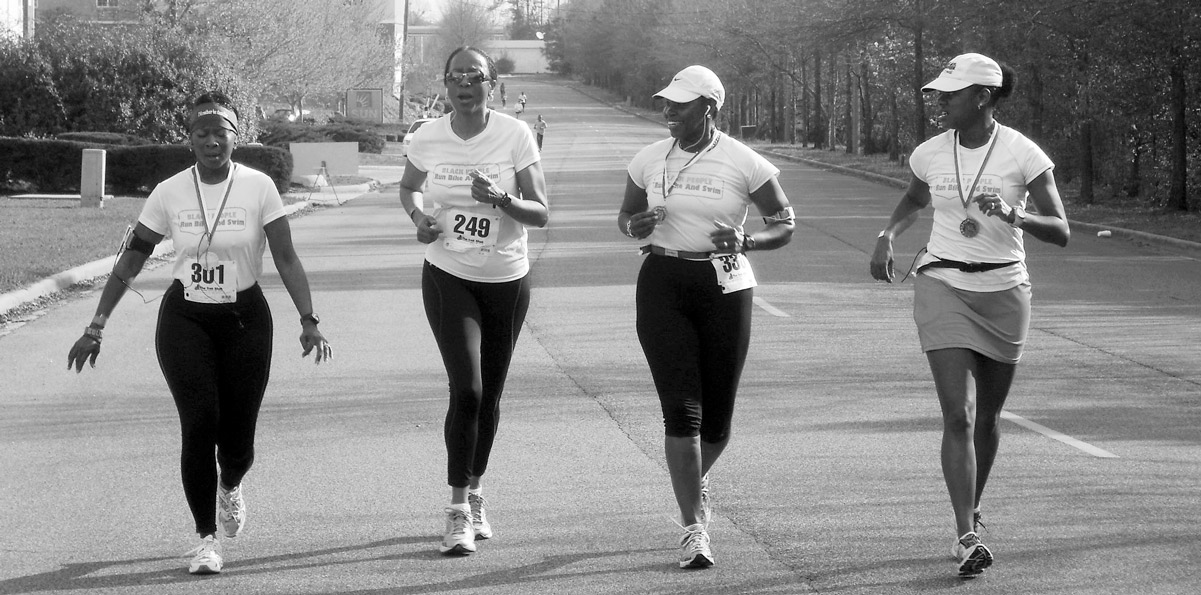 Courtesy of
Courtesy of
Black People Run, Bike & Swim
The benefits of regular activity are well-established, and it’s never too late to add more activity to your life. If you’ve been sedentary or have a chronic health condition, be sure to consult your personal physician prior to starting a new exercise or activity.
So what are the best ways to establish and maintain this healthy new routine? AARP has some tips for you.
Schedule a wake-up call
Use an alarm clock to wake yourself, but set your coffeemaker for the same time: The smell of coffee brewing will help motivate you to get up and get moving. What's more, coffee not only improves your mood and the chances you'll get out the door, but also makes you burn up to 15 percent more calories for three hours after exercise, and boosts endurance, too.
Remember when
Think of a positive memory involving exercise or an activity: a fun hike with your family, swimming at the beach on a beautiful day with friends, racquetball with your neighbor. Now, when you need that little push to get up and out, use that memory like a jolt of electricity. People who invoke positive memories exercise more frequently than those who don't, a University of New Hampshire study found.
Rock some new duds
Nothing motivates you to take up yoga or a fitness class like some new home-gym items or fitness wear. Forget the black yoga pants or sweats and get into a sleek new running top or body-flattering spandex leggings. Fun new gear can also help increase your willingness to keep training, says Hajo Adam of Houston's Rice University; he studies the effect of clothes on psychology.
Know thyself
Fitness isn't going to become a habit unless you make it easy on yourself. Part of that is knowing what works for you. The more you enjoy what you are doing, the more likely you are to continue to do it. If you need music, make a special playlist just for your workouts. Sample various gyms and pick the one where you feel the most comfortable.
Rest as needed
No one, and particularly those of us over a certain age, should try to sustain high-intensity exercise for every workout. That puts you at an increased risk of burnout — and prevents your body from fully recovering. The best way to tell if you're burned out? Take your pulse (putting fingers on neck or wrist, or via a mobile heart monitor) every morning for a week when you wake up. If it's seven beats faster than average, take a day off. Studies show that a rise in your morning heart rate is a sign of training fatigue.
Change it up
Boredom kills more exercise programs than burnout. A University of Florida study found that people who changed their workout every couple of weeks enjoyed exercising more and were more inclined to stick with their regimen than those who stuck to the same old routine. Cross-training serves the same end.
Keep track
Measuring success, whether it's steps taken in a day, frequency of workouts or your blood metrics, is a proven way to keep yourself coming back for more. People who record their exercise habits not only exercise more, they like it better, according to a recent review of studies from New York University. Keep a fitness journal, write your successes on your calendar at work, post your progress on social media for all your friends to see — anything to remind yourself that you've made progress and to motivate you not to go back to square one.
Think ahead
Getting in a fitness routine can be as simple as making it super easy to get to your workout. Try packing a gym bag the night before or laying out your workout clothes in the bathroom so they are unavoidable in the morning. Or block off time on your calendar so that your workouts are just another part of your day.
Be accountable
Nothing makes working out more enjoyable than setting a goal and pursuing it with a friend or two. Knowing other people are waiting for you before they can start is powerful motivation to get out the door. One Michigan State University study showed that people who work out with a partner or sports team exercise 200 percent longer than those who exercise by themselves.
Enlist your pooch
Even if your workout buddy is busy, your dog will never turn down an opportunity to be outside. Your four-legged friend might even inspire you to walk that extra mile or go a little harder than you had planned.
Weather the weather
If you exercise outside, you'll want to invest in some foul-weather gear — including wind- and water-resistant tops and bottoms — especially as the seasons change. Keeping dry is critical, particularly for older athletes: In cold weather, heat loss in wet clothes can be double those in dry conditions.